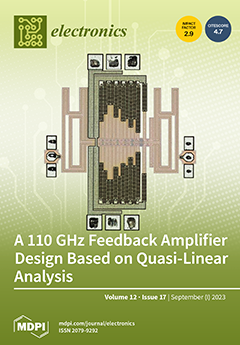Interconnects have become a major obstacle in chip scaling. Spoof surface plasmon polariton (SSPP) modes have gained attention for their ability to manipulate light beyond diffraction limits at a given frequency, leading to SSPP interconnects. This article investigates the transmission characteristics of SSPP
[...] Read more.
Interconnects have become a major obstacle in chip scaling. Spoof surface plasmon polariton (SSPP) modes have gained attention for their ability to manipulate light beyond diffraction limits at a given frequency, leading to SSPP interconnects. This article investigates the transmission characteristics of SSPP interconnect pairs placed side by side in the terahertz frequency range with comprehensive performance analysis. The proposed SSPP waveguide pair exhibits a maximum transmission coefficient of around −0.05 dB in the −3 dB band in the terahertz frequency range. Due to field confinement near the metal–dielectric interface, energy remains confined for the designed SSPP interconnect pair system. The proposed SSPP structure shows several bands in the terahertz frequency range, whereas conventional interconnects shows almost zero transmission at such frequencies. Additionally, the effect of geometric parameters on transmission coefficients (S
) and coupling coefficients (S
) has been investigated. Moreover, it has been shown that the bandwidth, as well as the upper cutoff frequency, can be tuned by varying the geometric parameters such as groove height, groove width and groove density. Since global interconnects undergo bending in actual circuits during distant data transmission on chips, geometric mismatches may occur between adjacent pairs of SSPP interconnects. Hence, it has also been examined how bending and mismatches affect transmission and coupling coefficients. Several SSPP schemes have been simulated, among which the best performance is obtained with 2
m mismatch in groove height. For this optimized design, two corrugated metal interconnects are considered with groove heights of 20
m and 22
m, respectively, a groove width of 3
m, a period of 20
m, and the number of grooves at 50. For this particular configuration, an ultra-wide passband is found having a bandwidth of almost 400 GHz, with a signal reflection of below −12 dB and little insertion loss of ∼−1.43 dB.
Full article





